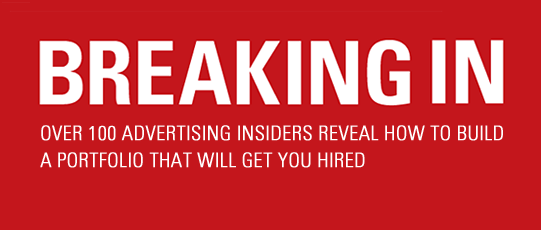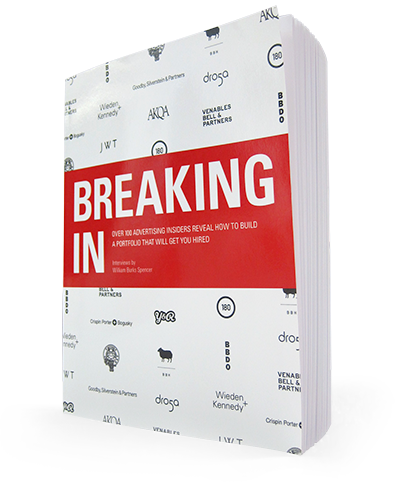In case you missed it, check out some of Tony Davidson’s work here.
WS: What do you think is a good way for people to improve? How would
you suggest that people get better?
TD: The way you learn is by being surrounded by interesting
things and better people. Go to venues, go to galleries, be inspired,
surround yourself. Just be curious about stuff and soak up other
creative influences around you. It’s part of your day job when you
actually get one: to get inspired. And it’s not about copying. It’s about
being influenced. Andy Warhol was influenced by [advertising]…the
artists are influenced by us, we’re influenced by them, and we’re both
influenced by culture.Second, and most importantly: See people that are better than you. Get
surrounded by people who are better than you. You have amazing access
in this industry, I think, to good creative people who have come through
the same process. So go and see them. If you like them when you go and
see them, keep coming back and seeing them without annoying them
too much. Kim and I, in all honesty, managed to get somewhere only
because we’ve been surrounded throughout our careers by good people.
We went to Leagas Delaney and saw Tim Delaney. He’s a fantastic writer.
He forced us to write a lot more. We had Dave Dye, Paul Belford—they
challenged our art direction. And then we went to BBH where we had
John Hegarty for the first year before he went off to America. And he
was incredibly helpful on Levi’s.I would also encourage you not to only see people in advertising
agencies. It is important that you have aspirations, I think, beyond that.
You might know an architect who is really interesting. You might do
some ideas with him or products or whatever it is. The great thing is
now the solution doesn’t have to be a press ad or a radio commercial. I
think you can open your mind up and go, “Here is the business problem,”
because that’s what a client really brings in or should do. And you can
solve it in any way. So if you got 5,000 cars sitting in a field, the answer
doesn’t have to be, “Oh, stick a press ad in local press saying we’ve got
5,000 cars.” You might think of an event. You might think of something,
some really clever, smart way that is relevant to that brand tonally, to
clear that field. And that’s where I get excited. When I see people who
are actually taking business problems and thinking about clever ways of
solving them.
WS: If you were just starting out now, what advice would you give yourself?
TD: If I were starting out, I’d be experimenting loads. I’d have my
own website and be making my own things. Daniel Eatock, who did
the Big Brother logo, is just constantly loading [his site] up with things
that he’s doing. Just random things, like car alarm dancing. He just
stands in front of car alarms when they’re going off and it’s hilarious.
He takes photographs of trees that are at angles but he straightens all the photographs so the tree strands straight. He’s not trying to solve an
advertising problem, he’s just putting stuff out there that interests him
and he’s got that side to him. He’s a lovely, lovely guy. He’s got something
to say and I hope one day we can utilize him to do a project with this stuff.
But he’s found the thing that he likes doing and he’s doing it. In the end
that’s what we all have to do as creative people. If you want to get into
advertising, then you have to find out what level of advertising you want
to get into. Because some people are quite happy sitting in a big agency
churning out stuff. Other people want to be in a high-end creative place
pulling their hair out. I don’t know how much you want it and how much
you don’t. People have to find where their creative outlet is and how they’re
going to utilize it.
WS: Any other tips or advice?
TD: Every student sends links to their site but, a lot of times, they
fail to edit and presume that creative directors have time to check all
their work. Editing is an important part of being a creative. It’s good if
the subject matter and brands vary. Show that you can do more than
one tone of voice. And it’s probably wise not to attempt to do work on
brands that have already got brilliant advertising, as your ideas will
immediately be compared to that work. And that’s part of the trick is to
find that tonality and then deliver whatever it is that you’re doing so that
it feels like it’s coming from the brand.Here’s another thing you can do: When you get a portfolio of ideas you
think is good, throw that portfolio away and start again and do another
portfolio. And then throw that one away and do another portfolio. And
then go back and pull all the good ideas together from all the portfolios.
And you might have a really great portfolio.I think, as a creative, you have to be really, really prepared to constantly
come up with new ideas and new thinking and not get too stuck on one
thing. People tend to tweak things only a little, when actually there’s
a better idea out there. So you have to be not too precious with your
ideas. And be careful about doing up the first idea that you’ve had. But
I think when it comes to seeing a creative director, hopefully you will
have been guided by the people you’ve seen before. I’m always wanting
to be surprised. You know, it was what Bill Bernbach always said: “If
you’re not surprised or you’re not being challenged, you’ll never notice
anything.” In the end, I’m looking at a lot of these books and they all feel
quite the same. Perhaps because a lot of people go through the same
courses, get the same briefs, and then they continue with that product.
So you’re even competing against other students who’ve got the same
products. I would pick stuff that no one else is doing because then at
least you’re not competing with them.


Comments are closed.